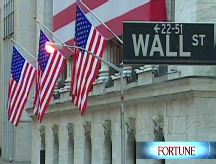A European-style tax?
Like it or not, there's only one way we're going to be able to pay for our ballooning deficit: a value-added tax.
 |
| European governments have seen VAT hikes as an easy way to raise revenues during a recession. |
NEW YORK (Fortune) -- It's highly possible, if not inevitable, that Americans will soon live under a radically different tax system - one that the pundits and politicians aren't talking about.
It's called a value-added tax, or VAT, and it's been used for decades to pay the bills and sustain the immense growth of governments around the world, from France to Mexico to Australia. Created in 1954 by a French economist, the VAT is the most potent, efficient machine for revenue generation yet invented.
And if there's one thing the U.S. government needs as the federal budget balloons, it's a ton of new revenue. "The bottom line is that the income tax cannot support the level of spending that's projected, something other countries faced years ago," said Roberton Williams of the Tax Policy Center, a non-partisan research institute. Today the VAT raises almost half of the total government revenue in France, and a similar share in most of the developed world.
The VAT is essentially a sales tax, except that it's charged at each stage in the development of a product instead of at the moment when the product is sold.
Take, for instance, a car with a sticker price of $30,000 and a value-added rate of 10%. Ford might buy its steel and other materials for $8,000 plus $800 in a VAT tax. A dealer then pays $25,000 plus a $2,500 tax for the finished vehicle. Ford takes an $800 credit for the tax it already paid and sends $1,700 to the government. A buyer then pays $30,000 for the SUV and $3,000 in taxes. The dealer collects the $3,000, takes a credit for the $2,500 worth of taxes already paid, and sends $500 to tax authorities. Ultimately, the government pockets $3,000, or 10% of the retail price of the car, in taxes.
The genius of the VAT is that, while the consumer pays it, the actual cash is mostly collected from producers before it reaches the retailer. Since the VAT is essentially a hidden charge embedded in the price of goods and services, raising the VAT doesn't arouse nearly the uproar caused by increasing income taxes.
The ease with which a VAT can be increased points to one of its big drawbacks: Governments see it as an easy way to pay for increased spending, which is a potential drag on economic growth.
Even so, the VAT would be better than the other likely alternative: A higher retail sales tax. If the national sales tax were raised to, say, 20%, consumers would cheat by paying cash to avoid it, and retailers would submit because they'd sell more goods by cutting the price 20%. With the VAT, every step of the manufacturing (and tax collection) process is documented.
Make no mistake: A VAT may be unavoidable in the United States. The reason is that spending is rising far faster than the revenue that can conceivably be generated by the current tax regime.
Let's examine the numbers. Under our current tax system, receipts are projected to remain pretty flat, at about 18% to 20% of GDP, far into the future. But spending is slated to rise to 24% of GDP in 2030 and 28% in 2050, excluding interest on the federal debt. If taxes aren't increased enormously, future deficits, and the enormous borrowing they require, will swamp the budget with ruinous interest costs.
Today, the income tax raises around $1.1 trillion, or around 9% of GDP, with payroll and corporate taxes contributing the balance. The deficit now stands at around $580 billion, including the Social Security surplus that's helping to pay the bills. But that surplus is also rapidly disappearing. So to balance the budget, America would need to raise income taxes by 53%, assuming the other taxes remained at current rates.
The gap gets far larger in the future, chiefly due to rapidly rising costs of Medicare and Medicaid. To pay for those costs, we'd need to raise taxes by an extra 2% of GDP. That would require an additional $270 billion in income taxes.
All told, that's a total tax increase of $870 billion, or almost 80%. That's not including the estimated $240 billion cost of President-elect Barack Obama's healthcare plan through 2018.
The rub is that the fiscal pillar America has relied on since 1913 - the federal income tax - can't possibly support the looming new era of spending. All economists agree that when top income tax rates get too high, Americans will work, save and invest less. Tax collections would increase far more slowly than rates, and eventually level off completely.
The VAT may be the only answer. "We're moving towards European levels of spending," said Andrew Biggs, an economist at the American Enterprise Institute "If you go there, you need a more efficient way to raise revenue."
But the VAT, on top of encouraging bigger government budgets, has another problem: Middle class taxpayers would be hit harder by a VAT because they spend more of their income on goods like clothing and cars than high-earners. That's especially distressing to Obama and Democrats, who have pledged to make the tax system far more progressive by raising rates for the wealthiest Americans.
One partial solution would be to exempt staples such as food, gasoline or fuel oil from the VAT and impose extra-high charges on yachts and jewelry. To help middle-class taxpayers, the federal government could also send subsidies to tens of millions of taxpayers based on their incomes. The French, for example, mail checks to families depending on how many children they have.
But given the nature of politics, said Biggs, "the problem is that those rebates might be tied to some social agenda, not to making the system fair."
European governments have typically seen VAT hikes as an easy way to raise revenues during a recession. In some countries, government spending is more than 50% of national income. The results have been fiscal stability, but lackluster growth and a dearth of dynamism and entrepreneurship.
Given the budget numbers, the United States has already chosen a path of far bigger government. The trap has been set. It's unlikely America can escape without a VAT. ![]()
-
 The retail giant tops the Fortune 500 for the second year in a row. Who else made the list? More
The retail giant tops the Fortune 500 for the second year in a row. Who else made the list? More -
 This group of companies is all about social networking to connect with their customers. More
This group of companies is all about social networking to connect with their customers. More -
 The fight over the cholesterol medication is keeping a generic version from hitting the market. More
The fight over the cholesterol medication is keeping a generic version from hitting the market. More -
 Bin Laden may be dead, but the terrorist group he led doesn't need his money. More
Bin Laden may be dead, but the terrorist group he led doesn't need his money. More -
 U.S. real estate might be a mess, but in other parts of the world, home prices are jumping. More
U.S. real estate might be a mess, but in other parts of the world, home prices are jumping. More -
 Libya's output is a fraction of global production, but it's crucial to the nation's economy. More
Libya's output is a fraction of global production, but it's crucial to the nation's economy. More -
 Once rates start to rise, things could get ugly fast for our neighbors to the north. More
Once rates start to rise, things could get ugly fast for our neighbors to the north. More









